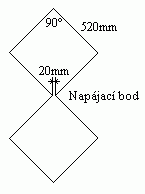Antenna DL7KM on 144 MHz
Today I want to introduce you to the antenna, which fascinated me a lot with several features: success (OM9M – MS / EME, racing equipment of TOP stations in OK), high profit, undemanding construction with acceptable dimensions (boom only 4.1m!). No other antenna on 144 MHz didn't interest me like this….
The article comes again from Zoli's OM7AQ: most of our stations use antennas according to F9FT and PA0MS when working on VHF / VHF bands. GW4CQT or Cheng-Cheng quads are rare, Cue Dee and only exceptionally antennas according to K1FO, DJ9BV, DL6WU or hybrid quad DL7KM. Antennas YU0B, W2NLY, W1JR, W6QKI, quagi W5UN or hybrid loop-yagi according to I3DLI are almost unknown. I would like to gradually introduce at least some of these antennas.
The DL7KM beam antenna consists of two 10-element YAGI hybrid antennas arranged one above the other. They are powered together by a double quad element. According to the literature, a double quad gains 2dB against a half-wave dipole. DL7KM states, that by measurement the whole antenna has gain 17dBd, the anteroposterior ratio is 25dB and the input impedance is around 60 ohm. The beam angle in the horizontal plane is 30 degrees and in the vertical 18. DL7KM beam has a great advantage over 2xYagi systems – no transforming or merging term is required. This eliminates losses, problems with impedance matching and difficulties in the actual design of the transformer and combiner. Another advantage is the fact, that the distance between the antennas is only 1.2m (in the radiation pattern this is manifested by the narrowing of the side lobes).

 Mechanical construction
Mechanical construction
The construction of the antenna according to DL7KM is shown in the picture. All passive elements are made of Al or AlMgSi with a diameter of 6 mm. The booms are made of a square AlMgSi 20x20mm profile. So that the antennas have sufficient stability, supports made of the same material, length approx. 3 m, are used. The elements are conductively attached to the boom. In the second picture there are two possible variants. Radiator (double quad element) is made of Cu material with a diameter of 5 mm or Al (AlMgSi) diameter 6mm. The dimensions are in the next picture. The radiator made of copper wire must be protected against corrosion by painting. It is attached to the boom insulated, preferably with Teflon or textile bakelite clips.
 Powering the DL7KM antenna
Powering the DL7KM antenna
According to the designer, we can supply the antenna directly with coaxial 50 or 75 ohm with less adjustment error. PSV in the range 144 – 146 MHz should be 1,4 to 1,7. If the PSV is higher, we can adjust the input impedance of the antenna by moving the emitter and the wall of the reflectors towards the first directors. The antenna input is symmetrical, but the coaxial supply without the balancing member causes only a slight deformation in one secondary lobe in the horizontal plane. Other parameters (main radiation direction, profit, anteroposterior ratio…) should remain unchanged.
Conclusion
It is advantageous to use the DL7KM antenna instead of systems with two YAGI antennas, when worries about adaptation disappear. In addition, the dimensions are very “pleasant”.
| R1, 2, 3 | 1055 |
| D1 | 935 |
| D2 | 930 |
| D3 | 925 |
| D4 | 920 |
| D5 | 915 |
| D6 | 910 |
| D7 | 905 |
| D8 | 890 |
| a | mast |
| b | 4100 |
| c | 3000 |
| d | 1600 |
| e | 450 |
gye@isternet.sk
http://om7aq.host.sk



